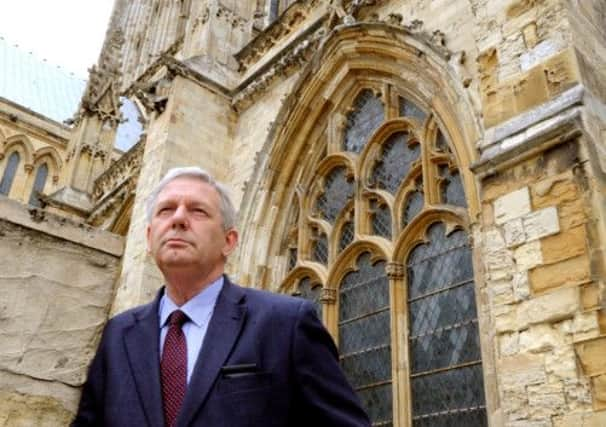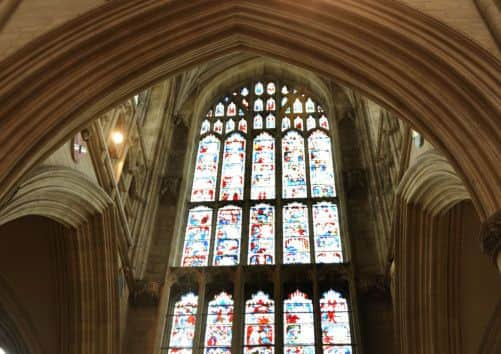Salvation by faith, hope and charity


Back in medieval times, the Church employed pretty shrewd methods for getting parishioners to part with their cash. While money might have been the root of all evil, it was also the route to forgiveness and for a few hundred years the sale of indulgences did a rip-roaring trade.
Would that Dr Richard Shephard could wind the clock back a few centuries, his job would be a whole lot easier. As Chamberlain and head of the York Minster Fund since 2003, he’s the man who has had to find the money to pay for the cathedral’s ongoing restoration and preservation work.
Advertisement
Hide AdAdvertisement
Hide AdA bit like the painting of the Forth Road Bridge, it’s a never-ending task and the sums involved are huge.


Yet such are Dr Shephard’s powers of persuasion in the last decade he’s helped add £25m to the cathedral coffers which has funded some of the most detailed and painstaking work in the Minster’s history.
“I swear I see people duck behind pillars when they see me coming, they fear that any conversation will end with a donation,” he says navigating a particularly narrow spiral staircase. It leads to the exterior of the Minster and a section of badly crumbling stonework. From the ground, the building looks in deceptively good shape. Up close however, the problems are glaringly obvious.
“One really mustn’t get consumed with horror stories,” says Dr Shephard. “Every five years a full survey of the building is undertaken and the lengthy report details long-term work, short term projects and work which has to be done yesterday.
Advertisement
Hide AdAdvertisement
Hide Ad“We always have a plan, but that doesn’t stop the need for firefighting.”
Dr Shephard has recently announced that he will step down from the fund next year, and the pragmatism which he has honed over the last decade is something his successor would do well to embrace. It is certainly not a job for those who have sleepless nights about a small patch of damp in the bathroom or a few loose tiles.
“Visitors come to this great building and often don’t realise the extent of the work we need to do here. The stone on the south side is in a very poor state and it will need replacing, holes are appearing in three windows in the north aisle, the glazing in the choir has cracks and some of the stone sculptures in the crypt have already succumbed to salt corrosion.
“We have an expert monitoring its progress at the moment, but as with everything to do with the Minster, the end result will cost time, money and expertise.”
Advertisement
Hide AdAdvertisement
Hide AdBefore Dr Shephard joined the fund, he had spent 30 years as headmaster of the Minster School and still leads the Evensong services. He was already part of the fixtures and fittings, but admits the post has been a huge learning curve.
“The key is never to allow yourself to think you are on top of things,” he says.
“The fund was founded in 1967 when the Minster’s central tower was threatened with collapse. It was headed then by Lord Scarborough who drove a £2m fundraising campaign. When that project was finished I think it became apparent that it was no good having one-off appeals whenever some new disaster struck, in order to survive for future generations, the Minster needed a full-time fundraising drive.”
Much of Dr Shephard’s focus in recent years has been on the York Minster Revealed project. Funded by a joint application with the Minster Chapter to secure Heritage Lottery money, the cathedral had to show how they would make the building more accessible. The result was the opening of the Orb, where delicate stained glass can be seen up close, a new piazza, better disabled access and a permanent exhibition which winds its way around the undercroft.
Advertisement
Hide AdAdvertisement
Hide Ad“The panels on the Great East Window won’t be back in place until 2016. It will be a momentous day, but by then I have no doubt the next project will already be lined up. There’s always a temptation after a big project is finished to go lie down in a dark room and think, ‘that’s it, all will be well’, but in a building this age and this size I learnt pretty quickly that all will never be well.
“It is partly because of its age, it’s partly because of the material it’s made out of – soft magnesium limestone – and partly because it’s been open to the elements for many hundreds of years.
“There was a period when people were burning a lot of fossil fuels that there was very poor air quality in the Vale of York and the stone has been assailed over the centuries by the elements.
“York Minster must have the best collection of stained glass in the country and we tend to forget that any one of our very pretty windows would look simply enormous in a normal parish church.
Advertisement
Hide AdAdvertisement
Hide Ad“However, of the cathedral’s 128 windows, 75 containing medieval glass have no protection from the elements. A number of them have become corroded and pitted.”
Before 2003 entry to the Minster was free. The decision to charge visitors was not universally welcomed – the then Archbishop of York threatened to invoke a 1,400-year-old law to stop it – but it came at a time when the building was operating an annual deficit of £600,000. Back then adults were being charged £3.50. Today it’s £15, but Dr Shephard says the income from admission only covers the cost of the day to day running of the building and routine maintenance.
A statement on the cathedral’s website says: “At a time of severe challenges, Yorkshire bluntness is perhaps the order of the day. York Minster cannot survive without your help.” While there are some visitors who will always be irritated by the presence of donation boxes, Dr Shephard says the funding of buildings like the Minster is often misunderstood.
“In the York Glaziers Trust we have some of the best experts in the country, if not the world and my job is to try to raise as much funding as possible to enable this talented team to carry out this work,” he says.
Advertisement
Hide AdAdvertisement
Hide Ad“People don’t always understand that there are 42 cathedrals in this country and not one of them receives any money from the government or the Church of England.
“In many ways we are blessed because we have access to a real depth of expertise. We all know the best possible methods of protecting a building, but we also know that those techniques are costly.
“We rely on a large number of donors, some give huge sums of money, some give regular, small amounts – there’s one couple who every Easter send me £5 or £10 and a little note about what they have been up to in the past year.”
Ensuring the money keeps coming is where Dr Shephard has earned his supper, whether it be keeping the regular donors happy to organising one-off headline-grabbing events, like the dinner last year for 900 guests which saw the Minster nave carpeted with 16,000 sq ft of special turf, or commissioning the artist Emma Bridgewater to design a special York Minster mug.
Advertisement
Hide AdAdvertisement
Hide Ad“You have to constantly think of new ways of parting people from their money; the one thing you want to avoid is donor fatigue – events in the Minster are special, but we don’t want to overuse it’s unique selling point.”
Standing below the St William Window, Dr Shephard says it is a prime example of the difference restoration work can make. Glaziers removed much of the heavy lead beading which had been used to repair damaged sections and having repainted some of the panels, when the light now shines through the effect is impressive. Opposite, the St Cuthbert Window, untouched in recent years, bears the scars of previous conservation methods, but that will be a project for a future head of the York Minster Fund.
“Having spent the majority of my working life at the Minster I think it’s important that when I do retire I step aside completely,” says Dr Shephard.
He may be right, but his will be big shoes to fill.